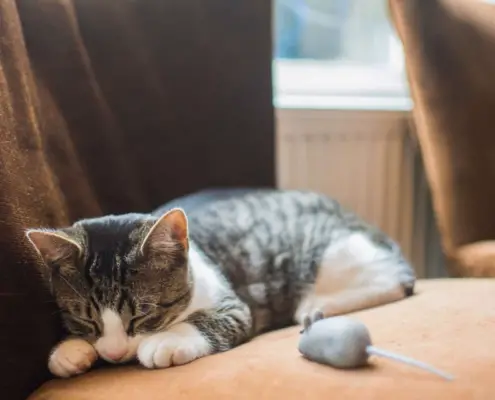
Cats are known for their independent and enigmatic nature. While they can form strong bonds with their human companions, they may not always get along with their feline counterparts. One common behavior observed among cats is hissing. This vocalization, often accompanied by an arched back and raised fur, serves as a warning signal to other cats. In this article, we will delve into the reasons behind cats hissing at their feline companions, helping you gain a deeper understanding of their behavior and find ways to promote harmony among them.
Understanding cat behavior and communication
Before delving into the reasons behind cat hissing, it is important to understand their behavior and communication methods. Cats use a variety of vocalizations, body postures, and scent marking to communicate with each other. Hissing is a vocalization that typically occurs when a cat feels threatened or uncomfortable. It is their way of saying, “Back off!” or “I’m not in the mood to socialize.”
The instinctual reasons behind hissing
Cats are instinctively territorial creatures, and hissing is often a response to protect their territory. In the wild, cats mark their territory by spraying urine or scratching surfaces, leaving behind scent cues that indicate their presence. When another cat encroaches on their territory, hissing becomes a defense mechanism to establish boundaries and ward off potential threats.
Territoriality and hierarchy in cat social groups
Cats are solitary animals by nature, but they can form social groups under certain circumstances. In these groups, a hierarchy is established, with dominant cats at the top and subordinate cats lower in the pecking order. Hissing can occur when a subordinate cat challenges the authority of a dominant cat or when a dominant cat asserts its dominance over a subordinate. It is a way for cats to maintain their position in the social hierarchy and avoid conflicts.
Fear and aggression as triggers for hissing
Fear and aggression are common triggers for cat hissing. When a cat feels scared or threatened, they may resort to hissing as a defensive mechanism. This can happen when they encounter unfamiliar cats, experience a sudden change in their environment, or feel overwhelmed by a stressful situation. Hissing serves as a warning to the perceived threat, signaling that the cat is ready to defend itself if necessary.
Introducing new cats: Tips for a smooth transition
Introducing a new cat into a household can be a challenging process, often leading to hissing and territorial disputes. However, with careful planning and patience, you can help facilitate a smooth transition. Firstly, it is important to keep the new cat separated in a separate room for a few days, allowing the resident cat to become familiar with their scent. Gradually, you can start exchanging their bedding or using pheromone sprays to help them associate positive experiences with each other’s scent. Slowly introduce them in controlled environments, such as through a cracked door or a mesh barrier. Gradually increase their interaction time while closely monitoring their behavior. Remember, patience is key, and it may take several weeks or even months for them to fully accept each other.
Addressing common misconceptions about cat hissing
There are several misconceptions surrounding cat hissing that need to be addressed. One common myth is that hissing is always a sign of aggression. While it can be a defensive response to a perceived threat, cats can also hiss out of fear, discomfort, or even playfulness. It is important to consider the context and other body language cues when interpreting a cat’s hissing behavior. Additionally, hissing alone does not necessarily indicate a long-term conflict between cats. With proper intervention and management, cats can often learn to coexist peacefully.
Ways to prevent or manage cat conflicts
If you have multiple cats in your household and conflicts arise, there are several strategies you can employ to prevent or manage these conflicts. Firstly, provide each cat with their own resources, including food bowls, litter boxes, and resting areas. This helps minimize competition and reduces the likelihood of hissing over resource guarding. Additionally, create vertical spaces, such as cat trees or shelves, to allow cats to establish their territory and escape from potential conflicts. Regular play sessions and environmental enrichment can also help alleviate tension and redirect their energy towards positive outlets.
Seeking professional help: When to consult a veterinarian or animal behaviorist
In some cases, cat conflicts may escalate to a point where professional intervention is necessary. If your cats’ hissing and aggressive behaviors persist despite your best efforts, it may be time to consult a veterinarian or animal behaviorist. These professionals can assess the situation, identify underlying causes, and provide guidance on behavior modification techniques or medication if needed. They can also help ensure that there are no underlying medical conditions contributing to the conflicts.
Promoting harmony among feline companions
Understanding the reasons behind cats hissing at their feline companions is crucial for promoting harmony in multi-cat households. By recognizing the instinctual nature of hissing, addressing common misconceptions, and implementing strategies to prevent or manage conflicts, you can create an environment where your feline companions can coexist peacefully. Remember, patience, understanding, and a little bit of extra effort can go a long way in fostering a harmonious relationship between your cats.
If you enjoyed my article, I would appreciate you sharing it with your network.

Sima Ndlebe
Sima writes for CatBuzz. He is interested in Cats, Health and Fitness, and Entrepreneurship.
Published: 1 June 2024



